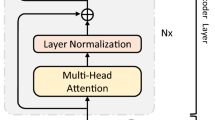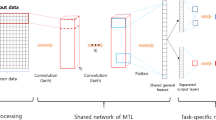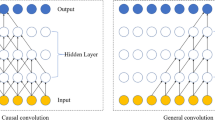Abstract
Remaining useful life (RUL) prediction is a key aspect of health condition monitoring, which can reduce maintenance costs and improve system operational efficiency. The most existing approaches only extract temporal features or spatial features, and ignore raw mapping features in RUL prediction. However, these different features are highly complementary and relevant for RUL prediction. Different from these approaches, we propose a novel feature-fusion-based end-to-end approach for RUL prediction in this paper, which combines spatiotemporal features and raw mapping features. To begin with, the time attention mechanism is used for the input to weight different time steps. Then convolutional neural networks (CNNs) are used for the weighted input to extract spatial feature maps. Between the CNNs, channel attention and spatial attention mechanisms are applied to the feature maps to learn the importance of channel and spatial distribution. Meanwhile, a bidirectional gated recurrent unit is adopted to capture temporal dependency features. In addition, the raw mapping features are obtained from the input through a fully connected layer to provide additional information. Finally, the three types of obtained features are fused for the final RUL prediction through fully connected networks. Extensive experiments are carried out on the C-MAPSS engine dataset. The results show that the proposed approach outperforms the current deep learning approaches.












Similar content being viewed by others
References
Babu, G. S., Zhao, P., & Li, X. L. (2016). Deep convolutional neural network based regression approach for estimation of remaining useful life. In International conference on database systems for advanced applications (pp. 214–228). Springer.
Cai, W., Zhang, W., Hu, X., & Liu, Y. (2020). A hybrid information model based on long short-term memory network for tool condition monitoring. Journal of Intelligent Manufacturing, 31(6), 1497–1510.
Chen, J., Jing, H., Chang, Y., & Liu, Q. (2019). Gated recurrent unit based recurrent neural network for remaining useful life prediction of nonlinear deterioration process. Reliability Engineering & System Safety, 185, 372–382.
Chen, M., He, X., Yang, J., & Zhang, H. (2018). 3-d convolutional recurrent neural networks with attention model for speech emotion recognition. IEEE Signal Processing Letters, 25(10), 1440–1444.
Chen, Z., Li, Y., Xia, T., & Pan, E. (2019). Hidden markov model with auto-correlated observations for remaining useful life prediction and optimal maintenance policy. Reliability Engineering & System Safety, 184, 123–136.
Chen, Z., Wu, M., Zhao, R., Guretno, F., Yan, R., & Li, X. (2020). Machine remaining useful life prediction via an attention-based deep learning approach. IEEE Transactions on Industrial Electronics, 68(3), 2521–2531.
Cheng, Y., Zhu, H., Wu, J., & Shao, X. (2018). Machine health monitoring using adaptive kernel spectral clustering and deep long short-term memory recurrent neural networks. IEEE Transactions on Industrial Informatics, 15(2), 987–997.
Chung, J., Gulcehre, C., Cho, K., & Bengio, Y. (2014). Empirical evaluation of gated recurrent neural networks on sequence modeling. arXiv preprint arXiv:1412.3555 .
Elsheikh, A., Yacout, S., & Ouali, M. S. (2019). Bidirectional handshaking LSTM for remaining useful life prediction. Neurocomputing, 323, 148–156.
Hochreiter, S., & Schmidhuber, J. (1997). Long short-term memory. Neural Computation, 9(8), 1735–1780.
Huang, C. G., Huang, H. Z., Li, Y. F., & Peng, W. (2021). A novel deep convolutional neural network-bootstrap integrated method for RUL prediction of rolling bearing. Journal of Manufacturing Systems, 61, 757–772.
Javed, K., Gouriveau, R., & Zerhouni, N. (2015). A new multivariate approach for prognostics based on extreme learning machine and fuzzy clustering. IEEE Transactions on Cybernetics, 45(12), 2626–2639.
Li, X., Ding, Q., & Sun, J. Q. (2018). Remaining useful life estimation in prognostics using deep convolution neural networks. Reliability Engineering & System Safety, 172, 1–11.
Li, Y., Zeng, J., Shan, S., & Chen, X. (2018). Occlusion aware facial expression recognition using CNN with attention mechanism. IEEE Transactions on Image Processing, 28(5), 2439–2450.
Liao, Y., Zhang, L., & Liu, C. (2018). Uncertainty prediction of remaining useful life using long short-term memory network based on bootstrap method. In 2018 IEEE International Conference on Prognostics and Health Management (ICPHM) (pp. 1–8). IEEE.
Liu, H., Liu, Z., Jia, W., & Lin, X. (2019). A novel deep learning-based encoder-decoder model for remaining useful life prediction. In 2019 International Joint Conference on Neural Networks (IJCNN) (pp. 1–8).
Liu, H., Liu, Z., Jia, W., & Lin, X. (2020). Remaining useful life prediction using a novel feature-attention-based end-to-end approach. IEEE Transactions on Industrial Informatics, 17(2), 1197–1207.
Liu, J., Liu, Y., & Zhang, Q. (2022). A weight initialization method based on neural network with asymmetric activation function. Neurocomputing, 483, 171–182.
Liu, R., Yang, B., & Hauptmann, A. G. (2019). Simultaneous bearing fault recognition and remaining useful life prediction using joint-loss convolutional neural network. IEEE Transactions on Industrial Informatics, 16(1), 87–96.
Mo, Y., Wu, Q., Li, X., & Huang, B. (2021). Remaining useful life estimation via transformer encoder enhanced by a gated convolutional unit. Journal of Intelligent Manufacturing, 32(7), 1997–2006.
Ng, S. S., Xing, Y., & Tsui, K. L. (2014). A naive Bayes model for robust remaining useful life prediction of lithium-ion battery. Applied Energy, 118, 114–123.
Nieto, P. G., García-Gonzalo, E., Lasheras, F. S., & de Cos Juez, F. J. (2015). Hybrid PSO-SVM-based method for forecasting of the remaining useful life for aircraft engines and evaluation of its reliability. Reliability Engineering & System Safety, 138, 219–231.
Pan, Y., Hong, R., Chen, J., & Wu, W. (2020). A hybrid DBN-SOM-PF-based prognostic approach of remaining useful life for wind turbine gearbox. Renewable Energy, 152, 138–154.
Qian, Y., Yan, R., & Gao, R. X. (2017). A multi-time scale approach to remaining useful life prediction in rolling bearing. Mechanical Systems and Signal Processing, 83, 549–567.
Ren, M., Zhang, Q., & Zhang, J. (2019). An introductory survey of probability density function control. Systems Science & Control Engineering, 7(1), 158–170.
Saon, S., Hiyama, T., et al. (2010). Predicting remaining useful life of rotating machinery based artificial neural network. Computers & Mathematics with Applications, 60(4), 1078–1087.
Saxena, A., Goebel, K., Simon, D., Eklund, N. (2008). Damage propagation modeling for aircraft engine run-to-failure simulation. In 2008 international conference on prognostics and health management (pp. 1–9). IEEE.
Woo, S., Park, J., Lee, J. Y., Kweon, I. S. (2018). Cbam: Convolutional block attention module. In Proceedings of the European conference on computer vision (ECCV) (pp. 3–19).
Xia, M., Zheng, X., Imran, M., & Shoaib, M. (2020). Data-driven prognosis method using hybrid deep recurrent neural network. Applied Soft Computing, 93, 106351.
Xia, T., Song, Y., Zheng, Y., Pan, E., & Xi, L. (2020). An ensemble framework based on convolutional bi-directional LSTM with multiple time windows for remaining useful life estimation. Computers in Industry, 115, 103182.
Yan, C., Tu, Y., Wang, X., Zhang, Y., Hao, X., Zhang, Y., & Dai, Q. (2019). STAT: Spatial-temporal attention mechanism for video captioning. IEEE Transactions on Multimedia, 22(1), 229–241.
Yang, B., Liu, R., & Zio, E. (2019). Remaining useful life prediction based on a double-convolutional neural network architecture. IEEE Transactions on Industrial Electronics, 66(12), 9521–9530.
Yang, F., Habibullah, M. S., Zhang, T., Xu, Z., Lim, P., & Nadarajan, S. (2016). Health index-based prognostics for remaining useful life predictions in electrical machines. IEEE Transactions on Industrial Electronics, 63(4), 2633–2644.
Yin, X., Zhang, Q., Wang, H., & Ding, Z. (2019). Rbfnn-based minimum entropy filtering for a class of stochastic nonlinear systems. IEEE Transactions on Automatic Control, 65(1), 376–381.
Yu, W., Kim, I. Y., & Mechefske, C. (2020). An improved similarity-based prognostic algorithm for RUL estimation using an RNN autoencoder scheme. Reliability Engineering & System Safety, 199, 106926.
Zhai, Q., & Ye, Z. S. (2017). RUL prediction of deteriorating products using an adaptive Wiener process model. IEEE Transactions on Industrial Informatics, 13(6), 2911–2921.
Zhang, C., Lim, P., Qin, A. K., & Tan, K. C. (2016). Multiobjective deep belief networks ensemble for remaining useful life estimation in prognostics. IEEE Transactions on Neural Networks and Learning Systems, 28(10), 2306–2318.
Zhang, K., Zuo, W., Gu, S., & Zhang, L. (2017). Learning deep CNN denoiser prior for image restoration. In Proceedings of the IEEE Conference on Computer Vision and Pattern Recognition (pp. 3929–3938).
Zhang, Y., Xiong, R., He, H., & Pecht, M. G. (2018). Long short-term memory recurrent neural network for remaining useful life prediction of lithium-ion batteries. IEEE Transactions on Vehicular Technology, 67(7), 5695–5705.
Zheng, S., Ristovski, K., Farahat, A., & Gupta, C. (2017). Long short-term memory network for remaining useful life estimation. In 2017 IEEE International Conference on Prognostics and Health Management (ICPHM) (pp. 88–95). IEEE.
Zhu, C., Chen, Z., Zhao, R., Wang, J., & Yan, R. (2021). Decoupled feature-temporal CNN: Explaining deep learning-based machine health monitoring. IEEE Transactions on Instrumentation and Measurement, 70, 1–13.
Zhu, J., Chen, N., & Peng, W. (2018). Estimation of bearing remaining useful life based on multiscale convolutional neural network. IEEE Transactions on Industrial Electronics, 66(4), 3208–3216.
Acknowledgements
This work was supported by the Major Special Program of Chongqing Science & Technology Commission (No. CSTC 2019jscx-zdztzxX0031), Graduate Scientific Research and Innovation Foundation of Chongqing (No. CYB21068 and No. CYS21067).
Author information
Authors and Affiliations
Corresponding author
Ethics declarations
Conflict of interest
The authors declare that they have no conflict of interest.
Additional information
Publisher's Note
Springer Nature remains neutral with regard to jurisdictional claims in published maps and institutional affiliations.
Rights and permissions
Springer Nature or its licensor holds exclusive rights to this article under a publishing agreement with the author(s) or other rightsholder(s); author self-archiving of the accepted manuscript version of this article is solely governed by the terms of such publishing agreement and applicable law.
About this article
Cite this article
Zhu, Q., Xiong, Q., Yang, Z. et al. A novel feature-fusion-based end-to-end approach for remaining useful life prediction. J Intell Manuf 34, 3495–3505 (2023). https://doi.org/10.1007/s10845-022-02015-x
Received:
Accepted:
Published:
Issue Date:
DOI: https://doi.org/10.1007/s10845-022-02015-x




